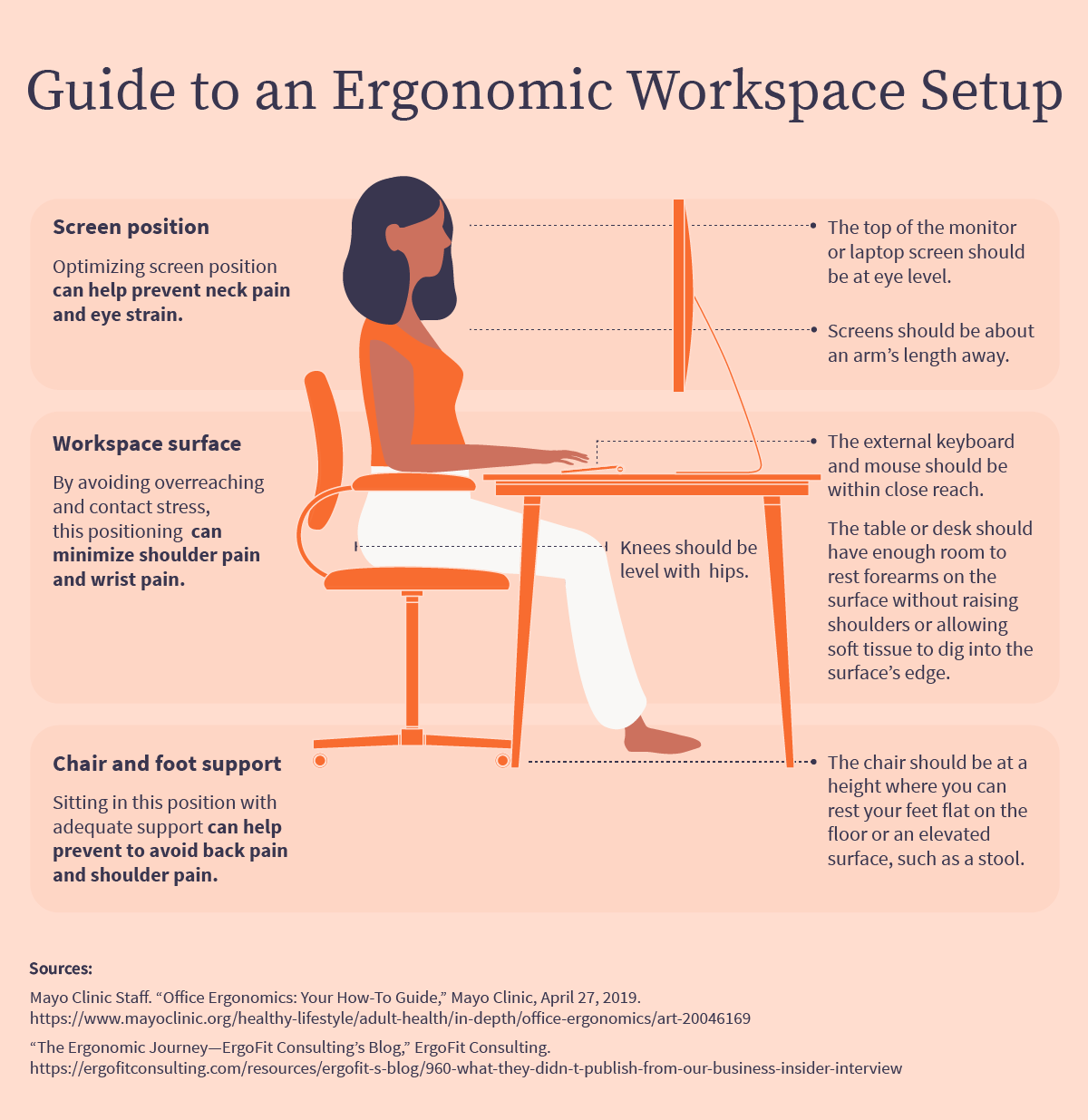How to Create an Ergonomic Work From Home Setup

When office professionals across the United States and the world were asked to work from home due to the COVID-19 pandemic, there was no certainty as to how long the situation would last. While some remote employees had preexisting home offices to retreat to, others were left to create a new space within their apartments or homes.
Whether your work from home situation is temporary or long term, part time or fully remote, it is important to fashion an office-like environment that is beneficial to your physical health.
Why Is It Important to Have an Ergonomic Workspace at Home?
While more people are now working from home due to restrictions caused by COVID-19, having the flexibility to do so isn’t new. According to a 2019 report from the Bureau of Labor Statistics, 29% of workers had the ability to work at home in their primary job in 2017–18.
Further, the pandemic has caused some organizations to rethink their work from home policies, with some projecting that companies may continue to allow employees to work from home at least part time after the pandemic.
According to the Centers for Disease Control and Prevention’s (CDC) Office Environment guide, a well-designed workspace allows an employee to work without:
- Needing to overreach
- Sitting or standing for too long
- Using awkward posture
While companies may provide ergonomic workspaces in their offices based on the advice of an occupational health specialist, working from home leaves the employee to make choices about their setup. Budget and space constraints may lead to a less-than-ideal situation.
Prolonged use of furniture that is not designed to provide ergonomic support as outlined by the CDC can lead to a variety of health issues, including neck pain, back discomfort and even gastrointestinal ailments, making it paramount for professionals to evaluate their home setups.
The top complaints professionals have about their work setup include:
- Neck pain
- Shoulder pain
- Back pain
- Wrist pain
- Eye strain
How to Optimize Your Work From Home Setup
According to Deborah Read, MOTR/L, president of ErgoFit Consulting, a non-ergonomic setup can cause additional health problems. For example, hanging part of your forearms off the edge of a desk due to lack of space can have a long-term effect on your nerves and muscle tissue.
Read explained that these problems can stem from ill-fitting furniture and can affect three key areas:
Posture
The size of a work surface and height of a computer monitor may affect your shoulder and neck positions, causing strain.
Contact stress
Inadequate space for a keyboard may cause arms to hang off the edge of a surface, damaging soft tissue. “Over time, that can lead to nerve injuries and sometimes vascular [issues],” Read said.
Foot support
If a chair is too high, feet cannot be firmly on the ground, which can affect back support and posture.

There are many things to consider when creating an ergonomic workspace, including monitor placement, the height of the work surface and chair, and foot support.
Go to the text-only version of this graphic.
Affordable and Adaptable Ergonomic Options
Creating the best possible work from home setup will depend on your individual preferences, amount of space and budget. Some may not have a designated office space and need adaptive accessories that can be set up and put away. Others may rely on items they can find at home to save money. Luckily, there are a variety of options to upgrade a workspace.

Things You Can Buy
- Laptop risers help raise a screen to eye level. The accessory is best paired with an external keyboard and mouse.
- Seat and lower back cushions can adjust the height and support of a regular dining chair for better posture.
- Table/bed risers can be used to securely raise the work surface to a more comfortable height if it is too low.

Things You Can Find at Home
- The kitchen table is often a good work surface, according to Read, as it provides space to set up a monitor or raised laptop, keyboard and mouse.
- Stacked books are an easy way to DIY a laptop stand to bring the screen to eye level.
- Boxes that are flat and firm can be used as a footrest to allow for firmly planted feet if the chair is too high.
Need inspiration for other ergonomic solutions? Read offered a list of products for creating an ergonomic workspace that you can buy to improve your workspace at home.
Staying Active When Working-From-Home
In addition to creating a workspace that is ergonomic, it is also important to stay active when working at home and limit sedentary hours to a minimum. Read emphasized the need for periodic movement, noting that those working from home should “stand and move at least two minutes every hour.”
There are also a variety of stretches and exercises that you can do to address health issues such as neck and back pain.
Physical Activity Breaks for Working From Home
Information last updated January 2021
Please note that this article is for informational purposes only. Individuals should consult their health care provider before following any of the information provided.
